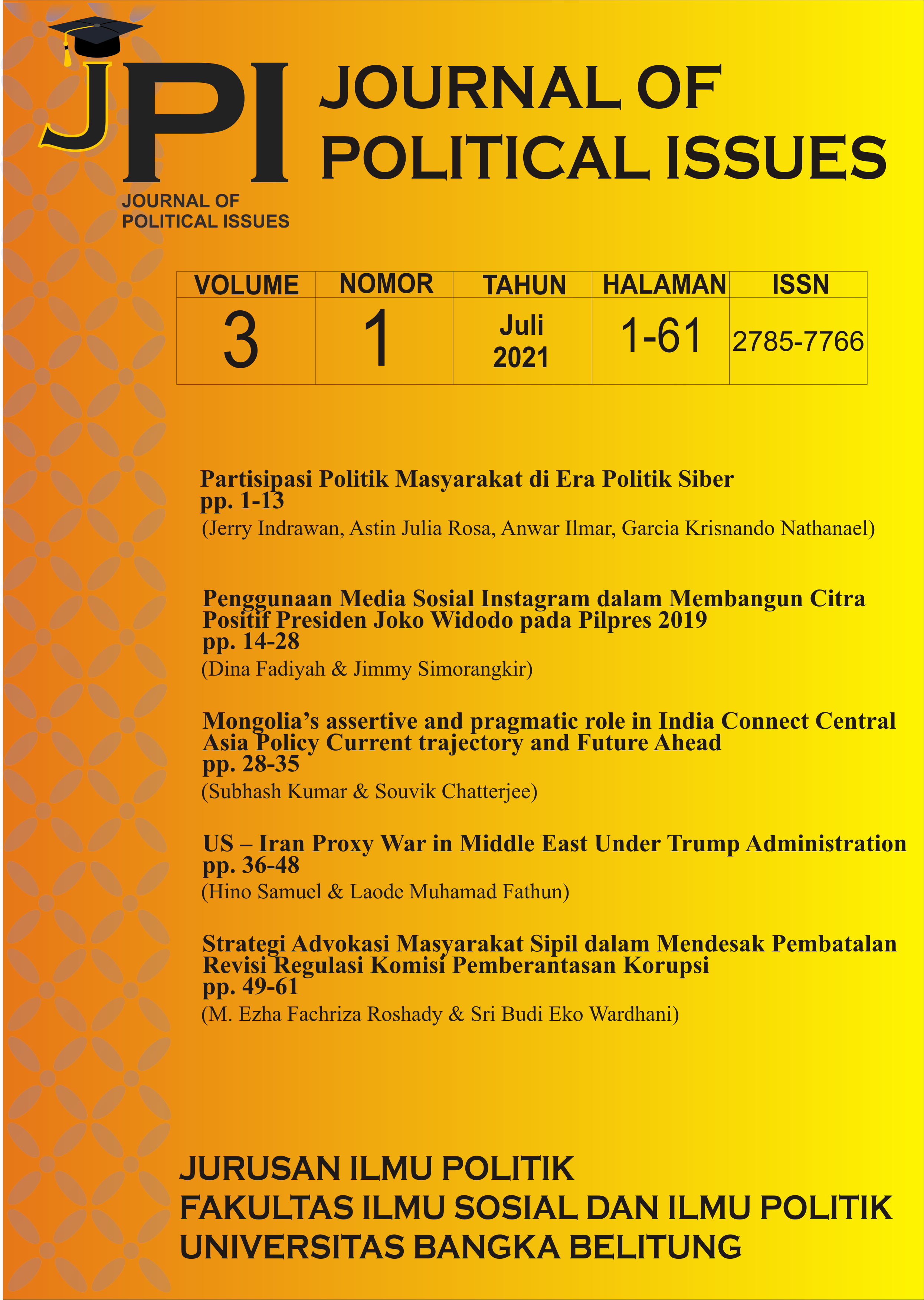Mongolia’s assertive and pragmatic role in India’s Connect Central Asia Policy: Current trajectory and Future Ahead
Abstract
Mongolia’s uniqueness and importance in contemporary world politics lie in its geographical situating, demography, and economy. Geographically landlocked and situated in the Eurasian intersection, Mongolia has the lowest population density of any sovereign country on the planet. Sandwiched among Russia and China Mongolia's harsh environment limit its economic interests. However, Mongolia's geostrategic position, unexplored energy assets, and democratic governance have expanded its importance in global politics. Because of such Mongolia holds a key position in India's Act East and Connect Central Policy to counter China's expansionist policies in North-East Asia. With regards to India-Mongolia relations, the two nations share a rich historical legacy. Tibetan Buddhism the most prevailing religion in Mongolia makes social linkages, Democracy solidified further connections between India and Mongolia. Because of these old and profoundly established linkages, India-Mongolia are 'spiritual neighbors'. However, China still has an overreaching control over Mongolia’s trade, commerce, and other sectors. China also dominates intra-regional trade in North-East Asia. Under India’s Connect Central Asia India attempts to counter Chinese encirclement by delving into close strategic, economic, and energy relations with China's neighbors like Mongolia and CAS. However, the achievement or failure of India's Connect Asia Policy will depend upon India's political as well as its diplomatic will to transform India's interest in regional integration in reality.
Downloads
References
Ahamed, M. S. (2012, June 12). Keynote Address at First India-Central Asia Dialogue on India’s ‘Connect Central Asia’ Policy at India’s ‘Connect Central Asia’ Policy. Ministry of Indian External Affairs Retrieved May 10, 2021 from https://www.mea.gov.in/Speeches-Statements.htm?dtl/19791/
Bulag, U. E. (2010). Mongolia in 2009: From Landlocked to Land- linked Cosmopolitan. Asian Survey, 50(1), 97-103. https://doi.org/10.1525/as.2010.50.1.9
Drishtiias.com. (2019). Connect Central Asia Policy. Drishti IAS. https://www.drishtiias.com/to-the-points/Paper2/connect-central-asia-policy
De, P., & Pan, S. (2017, October). India-Mongolia Economic Relations: Current Status and Future Prospect. The Northeast Asian Economic Review, 5(2), 31-47. https://ideas.repec.org/a/eri/review/5231-47.html
Goodson, J., & Addleton, J. (2020, January 29). How Great Power Competition Is Changing the Geopolitics of Mongolia. Retrieved from RealClear Defense: https://www.realcleardefense.com/articles/2020/01/29/how_great_power_competition_is_changing_the_geopolitics_of_mongolia_115003.html
Krishna, V. (2017). Mongolia’s Foreign Policy: Profiling Fundamental Aspects. International Journal of Applied Social Science, 4(9-10), 402-414. http://scientificresearchjournal.com/wp-content/plugins/download-attachments/includes/download.php?id=2569
Policy Planning and Coordination Department (2000). Mongolian Foreign Policy Blue Book., Ministry of External Relations. http://www.qingis.com/photos/foreign%20blue%20book%20eng.pdf
Nyamdavaa, O. (2003). Mongolia-India relations. New Delhi: Bhavana Books & Prints.
Nyamdavaa, O. (2015). Ancient Cultural, Ethnic and Religious Ties Between Mongolia and India. World Affairs: The Journal of International Issues, 19(4), 150-159. https://www.jstor.org/stable/48505253
Rossabi, M. (2009). Modern Mongolia from Khans to Commissars to Capitalists. Berkeley, CA: Univ. of California Press.
Stobdan, P. (2015, May 13). India and Mongolia: Modi on Ashoka’s Path. Retrieved December 2019, 20 from Institute for Defence Studies and Analyses: https://idsa.in/idsacomments/IndiaandMongolia_pstobdan_130515
The Hindu BusinessLine. (2021, January 08). India, Mongolia review bilateral cooperation in hydrocarbons and steel sectors. Retrieved 15 February, 2021 from The Hindu BusinessLine: https://www.thehindubusinessline.com/economy/policy/india-mongolia-review-bilateral-cooperation-in-hydrocarbons-and-steel-sectors/article33530455.ece
Xia, L. (2019). China Focus: Northeast Asian countries eye closer ties to boost global economy. Retrieved December 2019, 19 from Xinhuanet: http://www.xinhuanet.com/english/2019-08/27/c_138342481.htm
Copyright (c) 2021 Subhash Kumar, Souvik Chatterjee

This work is licensed under a Creative Commons Attribution-NonCommercial-ShareAlike 4.0 International License.
- Authors retain copyright and grant the journal right of first publication with the work simultaneously licensed under a Creative Commons Atribusi-Non Commercial-Share Alike (CC BY-NC-SA).
- Authors are able to enter into separate, additional contractual arrangements for the non-exclusive distribution of the journal's published version of the work (e.g., post it to an institutional repository or publish it in a book), with an acknowledgement of its initial publication in this journal.
- Every publication (printed/electronic) are open access for educational purposes, research, and library. Other than the aims mentioned above, the editorial board is not responsible for copyright violation.

















